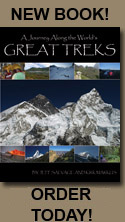 |
 |
Developing a Plan
 OK, so you’re checked out and ready to take for first steps. Preparing for a trek follows the same principles as a runner or walker preparing for a long distance competition. The key difference is only that you are not racing to a finish line, but instead enjoying the journey along the way. Forget the “No Pain No Gain” philosophy of the 80’s. Instead supplement “Minimum Effort, Maximum Gain.” We are not promoting laziness, just the opposite. By being smart, you maximize your training efforts and the return on your time investment.
OK, so you’re checked out and ready to take for first steps. Preparing for a trek follows the same principles as a runner or walker preparing for a long distance competition. The key difference is only that you are not racing to a finish line, but instead enjoying the journey along the way. Forget the “No Pain No Gain” philosophy of the 80’s. Instead supplement “Minimum Effort, Maximum Gain.” We are not promoting laziness, just the opposite. By being smart, you maximize your training efforts and the return on your time investment.
Training is about adapting the body to stress so that it gets stronger and thus increasing its ability to handle more stress in the future. Toughing your body up to withstand the stress of your trek is the key. This is not done over night. The longer your daily treks are and the more days you trek, the longer it takes to prepare.
Trekkers need a balanced approach, strengthening the entire body, if they are to be successful and injury free during training and during the trek. Everybody has a weakest link that if broken, slows or possibly prematurely brings the trek to an end. It is important to strengthen your weak links as well as the major muscle groups. In addition, a weak link may develop where you previously did not have an issue. Imagine being in great shape, but wearing ill-fitted boots and developing a severe blister. Unless you have an incredibly high pain threshold, that blister will slow you down and actually may cause other injuries since you will then favor the blistered foot.
The key behind many successful training programs is the concept of “specificity of exercise.” If an athlete wants to succeed, they must train in a manner similar to the activity they desire to excel at. While other activities help, if an athlete does not perform the activity they compete in they minimize the improvement achievable. Similarly, a trekker’s best method to train for a trek is to well, trek.
Unfortunately, that is far easier said than done. Few of us have a trail similar to the one traversed in the trek. Since, many trekkers do so on vacation in a location other than their native habitat, what do you do if you live in a city or in a flat land? How can you practice walking up and down a rocky path? So our ideal is probably unachievable for most. Further complicating matters is that you can not simulate altitude or weather easily.
With that said, continue reading to see some guidelines about training.
